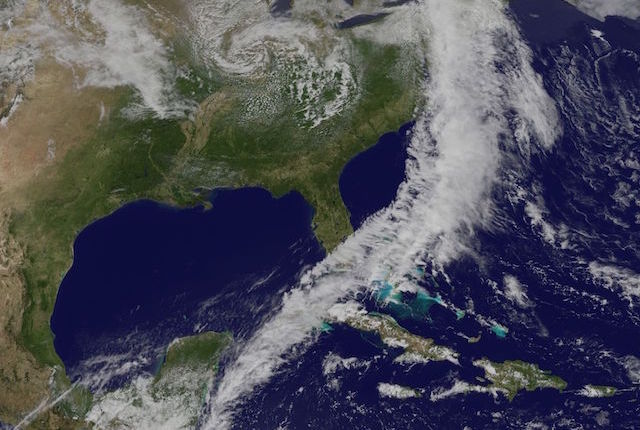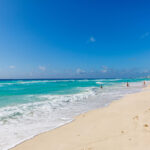Hurricane season has officially arrived -- and with that comes the loaded question: is it safe to travel? Many hit the road during this time of year to avoid the peak-season crowds and save more than a few bucks on flight and hotels, while others hunker down at home to avoid the risk of getting rained out -- or worse, having to evacuate, in the event of an emergency.
If you feel more at ease hearing it from a well-trained meteorologist, take it from Christopher Landsea, Science and Operations Officer at the National Hurricane Center. “Yes, I would certainly recommend vacationing during hurricane season,” he says. “But you need to be prepared and have a plan.” That’s where we come in. We spoke to several experts, including meteorologists as well as the founder of a top travel insurance company, to get the scoop on what you need to know before traveling during hurricane season.
Photo courtesy of NASA Goddard Space Flight Center via Flickr
When is hurricane season in Florida — and how likely are you to get hit?
Hurricane season officially begins on June 1 and lasts until November 30. Although Florida can be struck by a hurricane any time during this six-month period, the risk is highest near the end of August and into September. In September, Florida can get hit on either side of the coast — the Atlantic or Gulf side — while in June, July, and November, it’s rare to have a major hurricane (that is, a category 3, 4, or 5 on the Saffir-Simpson scale).
It’s important to note that although no part of Florida is immune to tropical weather, the probability is still pretty low. “For example, if you live in Key West and you’re there for the whole month of June, your chance of getting hit by a hurricane about is two percent,” says Landsea. “And if you’re in Key West for the entire month of September, the peak of the season, your chance goes up to about six percent.” Chris adds, the places at the highest risk of a hurricane are the Florida Keys and Miami (about a 15 percent chance, if you’re there the whole hurricane season).
What will hurricane season look like this year in Florida?
According to meteorologist Jason Meyers, most signs point to an average to above average season this year. “According to the National Hurricane Center, this translates to between 11 and 17 named storms,” he says. “Of those storms, five to nine are likely to become hurricanes and between two and four of those will become major hurricanes — that is, category 3 or bigger.”
Are some areas better protected than others?
While no part of Florida is invulnerable to a hurricane, there are parts of the coast that get hit less because of the direction the hurricane is coming from, as well as the orientation of the Florida coast. From June through November, the Florida Keys and Miami have about a 15 percent chance of being struck, according to Landsea. The percentage drops as you move northward — it’s about a six percent chance in the Cedar Key area and Jacksonville for the entire duration of hurricane season. Lastly, the odds do spike a bit as you head towards to the Panhandle. For Pensacola, it’s about a 10 percent chance, for example, explains Landsea.
How will hurricane season in Florida be different this year?
Last year, Florida was hit by Tropical Storm Colin, Hurricane Hermine, and had a close call with Hurricane Matthew. “This year is looking like there will be just as much activity in the Atlantic, but it’s too difficult to say with any accuracy whether any of those storms will hit Florida,” says Meyers. “To touch on climate change, the ocean is warming up as a result, and warmer oceans mean bigger and stronger hurricanes since hurricanes get their energy from the warm ocean water.”
What are some tools to monitor hurricanes ahead of (and during) a trip?
Keep an eye on the weather leading up to your trip. “Hurricanes and tropical storms typically have a long life, from forming in the Atlantic or Gulf of Mexico to eventually making their way to land, if they ever do,” says Meyers. “One to three weeks before your trip, begin checking the weather every or every other day.” Meyers recommends using the National Hurricane Center, which offers an easy, user-friendly map that displays what hot spots meteorologists are watching. If a tropical storm or hurricane forms, track it on weather apps like Storm Shield, which allows folks to save multiple locations, making it easy to check the weather for your home and your vacation spot, says Meyers. In addition, the app will send you weather alerts, like hurricane watches and warnings, for any of your saved locations. Local forecast offices also provide specific predictions for specific days. Of course, once you make it to Florida, continue monitoring the weather, and listen to authorities if evacuation orders are given.
“We strive to provide a lead time of three to five days,” says Landsea. “When we see a specific hurricane coming towards the coast, we issue a hurricane watch — meaning hurricane wind conditions may be expected in the next two days. Then, as it gets closer, we issue a hurricane warning, which means we’re expecting hurricane conditions somewhere in the warning area within the next 36 hours. When the warning is issued, that’s when people need to decide if they should hunker down, put up shutters, and stay in place, or prepare their homes and evacuate if the local authorities say you need to get out.”
What are the best ways to prepare for a visit to Florida during hurricane season?
“The best way to prepare for travel during the hurricane season is to be informed,” says Stan Sandberg, co-founder of TravelInsurance.com. That means making sure you know the cancellation policies for your airline and hotel with respect to tropical storms and hurricanes. It’s also worth asking your hotel about their hurricane emergency plans and procedures.
Don’t forget to read up on your destination. Is it an area that experiences severe flooding during storms? Are there obvious evacuation routes? What is the closest hospital in case of an emergency? Answering these questions will help you be prepared and navigate an emergency with ease.
That said, “you should cancel a trip if it looks like a tropical storm or hurricane is moving toward your destination,” says Meyers. “If you’re already there, and a storm is expected, listen to authorities’ instructions, and understand that it may be time to cut your vacation short.”
Should you purchase travel insurance?
Sandberg highly recommends purchasing a travel insurance plan with trip cancellation and trip delay provisions specifically related to severe weather and hurricanes. “Many travel insurance plans will provide full trip cancellation coverage if a hurricane or tropical storm causes a shutdown in services for an extended period of time,” he says. “Some plans will even include cancellation coverage for a NOAA hurricane warning for your destination.” Keep in mind that once a storm is named, it’s no longer possible to purchase travel insurance to protect against any losses from that named storm. With that in mind, it’s worth purchasing a travel insurance plan as soon as you’ve booked your trip.
What are some things to look for when purchasing travel insurance?
First things first: timing is key. Don’t procrastinate purchasing your insurance. “It’s ideal to purchase travel insurance within days after the initial payment of the trip,” says Sandberg. “Once a storm is named, you can no longer purchase travel insurance with cancellation coverage to protect your investment.” This applies to hurricanes, snowstorms, tropical storms, and any other major weather event.
There are often strict requirements of when to purchase these plans in order to qualify for the benefit, Sandberg tell us. “Some plans require that you purchase the plan within a short window — typically seven days — from the date you made the first payment toward you trip,” he says. “Also, the cancellation generally must take place more than 14 days after you’ve purchased the insurance.”
When it comes to choosing the right plan, it’s important to read the fine print. “Some plans require a complete shutdown of your airline for 24 consecutive hours before letting you cancel,” says Sandberg. “Others require a 48-hour shutdown before cancellation is allowed. Similarly, for the trip delay benefit to be available, some plans require a six-hour travel delay, while others require a 12-hour delay.” Plus, when reviewing plans, ensure the policy you purchase is comprehensive, and that it specifically offers hurricane coverage as part of the reasons for trip cancellation, trip interruption, and trip delay benefits, Sandberg recommends.
You’ll Also Like:
- What You Need to Know About Your Hotel If a Hurricane Strikes
- 5 Caribbean Islands (Generally) Not Hit by Hurricanes
- How to Score Good Weather (While Paying Rainy Season Rates) in Costa Rica
All products are independently selected by our writers and editors. If you buy something through our links, Oyster may earn an affiliate commission.



